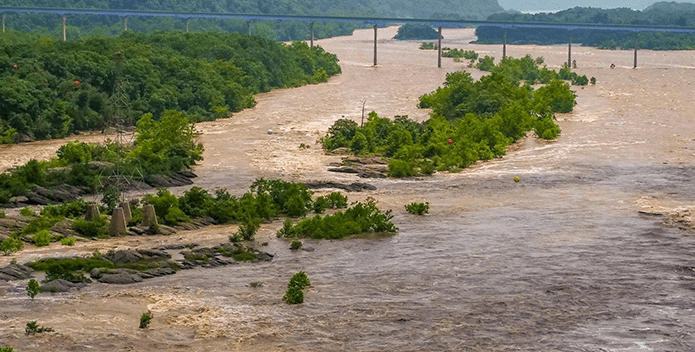This was first published in the Bay Journal.
Veteran newspaper photographer John Pavoncello has been eye-to-eye with all kinds of human drama.
In the short time his drone imaging business has been up and running, Pavoncello has gone above and beyond to record traumas faced by fire and law enforcement first responders.
But it was the sight of nature's powerful force that he called "crazy."
Pavoncello was contracted by the Chesapeake Bay Foundation to fly his camera over a portion of the lower Susquehanna River after a week of relentless rainstorms in late July.
Pavoncello has seen the river at its beautiful best in spring, and bulging with damaging ice flows in winter. But never like this. The Susquehanna was an angry, swollen, chocolate-colored torrent. "You just don't get the perspective standing along the bank," Pavoncello said, thinking back on the magnitude of roiling, brown water.
This aerial perspective of the deluge of runoff illustrates powerfully the urgency that more solutions must be found on the ground.
It just so happens that one of the most ambitious and challenging efforts to reduce the pollutant payload that flows into the Susquehanna and other commonwealth waterways is taking root.
The Keystone 10 Million Trees Partnership is a collaborative effort, coordinated by the CBF, to add 10 million trees to Pennsylvania's landscape before the end of 2025.
Trees alongside streams and streets are among the most cost-effective tools for cleaning and protecting waterways. The canopy and deep roots allow rain to soak into the soil, stabilizing streambanks, improving soil quality and keeping streams cool for fish like brook trout.
The partnership, launched in April, has galvanized national, regional, state and local agencies, conservation organizations, watershed groups, conservancies, outdoors enthusiasts, businesses and individuals.
In the partnership's first month, about 1,500 volunteers and the CBF's restoration specialists planted 31,000 trees at more than 50 locations.
The Arbor Day Foundation, along with Pennsylvania Departments of Agriculture, Conservation and Natural Resources, and Environmental Protection, are among the partners.
The commonwealth is significantly behind in meeting its pollution-reduction commitments and the Keystone 10 Million Tree Partnership can jump-start efforts to close the gap.
Roughly 19,000 miles of Pennsylvania's rivers and streams are impaired by polluted runoff and the legacy of coal mining.
The commonwealth's Clean Water Blueprint calls for about 95,000 acres of forested buffers to be planted in Pennsylvania's portion of the Chesapeake Bay watershed. Adding 10 million new trees alongside streams, streets and other priority landscapes would accelerate the Keystone State toward its clean water goals, achieving as much as two-thirds of the 95,000-acre goal.
Special emphasis has been placed on planting trees in the southcentral Pennsylvania counties of Lancaster, York, Adams, Cumberland and Franklin. All are thriving agricultural regions, which contribute the greatest amount of pollutants that flow into the Bay.
Response to the spring season of tree plantings has been encouraging. Additional groups in and out of Pennsylvania's portion of the Bay watershed have been asking to join the partnership.
That's good, as planting 10 million trees by the end of 2025 will take many hands.
Between planting seasons, summer months were for maintaining trees already planted.
Partners in Pequea Park, Lancaster County were successful, losing just three of 200 larger trees planted.
Conodoguinet Creek Watershed volunteers maintained their plantings by carrying water to seedlings during a heat wave.
The effort's partners will add more trees from September through November.
In 2019, the partnership hopes to nearly double its impact. That means that 50 planting partners will engage at 100 planting sites, 3,000 volunteers will be mobilized and 50,000 trees will go into the ground next spring.
Benefits from the trickle-down effect of so many plantings extend beyond the cleaner water that flows from them.
The need for so many trees, tubes, stakes and other supplies has also provided an economic boost to nurseries and other companies that can supply them.
As for the mighty, muddy Susquehanna, there may not be enough trees to withstand such an unusual force of nature as seen through John Pavoncello's lens. But the lasting images should be a reminder that consequences downstream could be less "crazy" if more trees are working upstream.
To learn about the Keystone 10 Million Trees Partnership, visit TenMillionTrees.org.




